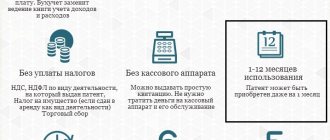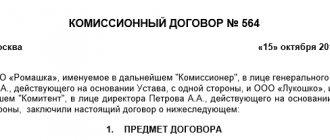You should not expect that the first problem that a person who decides to open an LLC or individual entrepreneur will face will be the need to understand the complex system of state classifiers, codes and abbreviations. However, over time, when the primary documents are drawn up and the head of the newly created company can gradually begin to conquer living space in the market, one will have to delve into the intricacies of domestic and European classification and deciphering incomprehensible terms - or it will be necessary to use the appropriate reference books, which will make life much easier for a businessman.
One of the most commonly used codes in the Russian Federation is OKPD 2; You can’t do without it when carrying out almost all types of activities. How the abbreviation stands for and where you can download a complete reference book on OKPD 2 codes is in the following brief explanation.
What is OKPD2?
The abbreviation OKPD stands for “All-Russian Classifier of Products by Type of Economic Activities.” Each product that is produced or service that is provided corresponds to a specific item from OKPD2. The product standardization system in Russia is built on the basis of the classification adopted in the EEC countries.
The classifier is used for various purposes, for example, for statistical research, in the preparation of regulatory documents. One of the important functions of the code is use in government procurement. Moreover, knowledge of OKPD2 of the product is required by both parties.
To the customer:
- To create a purchase identification code. This code consists of 36 digits and includes part of the OKPD2 code (30-33 digits). For example, if mineral water is purchased as part of a government order, it will include the first four digits of OKPD2 - 11.07.
- To prepare documentation for the tender, for example, a schedule.
- To place data in the EIS.
To the participant:
- To determine what type of product it belongs to, and, therefore, in what government procurement it can participate.
For some categories of suppliers or certain goods and services, there are restrictions or, conversely, advantages when participating in government procurement. In this case, customers are guided by OKPD2 codes, which are listed in the relevant government regulations. For example, Government Decree No. 102 of February 5, 2015 establishes restrictions on the purchase of medical products from other countries.
Are OKVED and OKPD the same thing?
There is an opinion among inexperienced users that these tools literally copy each other and do not carry a separate meaning. Indeed, if you look at the structure of these classifiers, you can conclude that they are very similar. Then what was the point in seriously wasting public funds on the development of two identical encoders? And what is the difference between OKPD and OKVED honey? She is. Only at first glance it may seem that these are identical classifiers. However, they have completely different functionality and are designed to solve different problems.
The All-Russian Classifier of Types of Economic Activities is a tool that contains codes for absolutely all types of professional activities within the state. In other words, thanks to its numerical expression, it describes any type of business that a person is engaged in in Russia. This is necessary to maintain accurate records, analyze the country’s economy and timely make adjustments, financing and other measures to correct the situation. In addition, thanks to the data contained in the Unified State Register of Legal Entities and Unified State Register of Individual Entrepreneurs, tax rates are calculated and all kinds of deductions are collected from enterprises and individual entrepreneurs.
The All-Russian Classification of Products by Type of Economic Activity is the main tool that promotes effective interaction between the manufacturer, seller and consumer. So the OKVED-2 and OKPD-2 classifiers are used in completely different situations. The first is for tracking the activities of entrepreneurs and legal entities, as well as simple coding to describe their profile areas. The second is as a universal language in the field of public procurement.
Structure of the OKPD2 classifier
The OKPD code can contain from two to nine characters. Each additional number clarifies the content and ultimately leads to a specific product or group of goods or services. In the European coding there are only six characters to designate products. There are three more signs for the Russian economy. Let's look at an example:
| Decoding | Example | ||
| XX.X | Class | 10. | Food products |
| XX.X | Subclass | 10.6 | Flour and cereal products, starches and starch products |
| XX.XX | Group | 10.61 | Flour and cereal production products |
| XX.XX.X | Subgroup | 10.61.3 | Cereals, wholemeal flour, granules and other grain products |
| XX.XX.XX | View | 10.61.33 | Breakfast cereals and other cereal products |
| XX.XX.XX.XX0 | Category | — | — |
| XX.XX.XX.XXXX | Subcategory | 10.61.33.116 | Rice flakes |
For the product from the example, a special subcategory has been allocated in the classifier. Sometimes a category does not contain additional division into subcategories. Then the last digit of the code is 0. For example, 17.24.11.110 is OKPD for the product “Wallpaper”.
For some types of products, division into categories is not provided. In these cases, the code is in the format XX.XX.XX.000. For example, 17.24.12.000 means the product “Textile materials for gluing walls.”
Why do you need an OKPD2 code classifier?
Classifiers OKPD2 and TN VED are used by organizations and entrepreneurs to uniquely identify goods and services. The foreign economic activity product nomenclature is used when carrying out foreign economic transactions (export and import), while OKPD2 is used in the following areas of activity according to the legislation of the Russian Federation:
- tax legal relations, since reporting is prepared according to the classifier, the right to preferential VAT rates is confirmed (Resolution of the Government of the Russian Federation No. 908 was adopted on this issue);
- reporting and interaction with Rosstat services;
- preparation of technical specifications, placement of schedules, tender documentation and other mandatory actions in the field of procurement under 44-FZ and 223-FZ;
- to undergo mandatory and voluntary certification and licensing procedures;
- for proper document management in commercial transactions;
- for registration of internal documentation of the enterprise.
Decoding OKPD2 codes allows you to accurately determine the type of product. The maximum number of indicators in the code (9) means that the products are precisely defined by classes, subclasses, groups, subgroups, types, categories and subcategories. The first 4 digits usually coincide with the data from the OKVED directory, as they characterize the type of activity of the enterprise.
In the public procurement system, searching for a notice, submitting an application, concluding a contract and posting reports is impossible without knowledge of OKPD2 codes. The customer, when placing an application in the bidding information system, indicates an accurate description of the goods or services he needs. Therefore, when searching among tens of thousands of notices, you can manually select the desired items, or indicate the product code in the online form. Reporting based on the results of tenders is also generated in a similar way, and according to the indicators of the classifier, interested parties and government departments can check the purchase.
Why is it important to choose the right OKPD2 code?
Situations arise when the customer indicates an incorrect OKPD2 in the procurement documents. The Letter of the Ministry of Economic Development of the Russian Federation dated February 17, 2016 No. D28i-344 states that administrative liability for incorrect OKPD2 is not provided. However, the same document notes that the control function in the contract system is performed by the FAS RF.
If it turns out that due to an incorrect choice of OKPD2, the customer has limited competition and chosen the wrong procurement method, sanctions will follow. Thus, for asserting an incorrect method of identifying a supplier, a fine is imposed:
- 30,000 rub. – in competitive procurement;
- 50,000 rub. – in procurement from a single supplier (clauses 1 and 2 of Article 7.29 of the Code of Administrative Offenses of the Russian Federation).
A government procurement participant should know the exact OKPD2 code of his products in order to more accurately customize his procurement search and know what restrictions or advantages apply to his products.
OKPD 2 code decoding
The basis for the standardization of goods and services is the statistical classification by type of activity (CPA) - a document adopted in European countries. Domestic codes are based on the same principles, but taking into account the peculiarities of the Russian economy. The six-digit alphanumeric values were retained, but additional digits were added to them - up to 7-9, which clarify and detail the product description.
In OKPD 2, services and goods are divided by type of economic activity and have the form of a hierarchical structure. The code can consist of a combination of 2-9 groups of characters. If you enter the designation of one of them with the letter “A”, then the representation formula will take the form:
- AA - class of services or goods;
- AA.A - subclass;
- AA.AA - group;
- AA.AA.A - subgroup;
- AA.AA.AA.AA0 - category;
- AA.AA.AA.AAA - subcategory.
Symbols No. 7,8,9 are designated as “0” when detailing is not carried out in the Russian Federation. The last digits of the code indicate when the service or product can be divided into a number of categories or subcategories.
Example:
01.13.21.130 - tropical nuts;
01.13.21.131 – coconuts (tropical subcategory)
01.13.21.132 – nuts from Brazil;
01.13.21.133 – cashew nuts.
If required, in some cases explanations are provided to help clarify the information.
Reference: OKPD 2 was developed to replace OKP and OKPD and is largely consistent with the European classification system,
How to find out OKPD2?
You can find the code either in the Order of Rosstandart dated January 31, 2014 No. 14-st, or using special services. You can select OKPD2 code by name using the Kontur.Snab service. To do this, type the product or service in ordinary words in the search bar. For example, “milk chocolate”:
Sometimes it is difficult to select OKPD2 - for example, if a product or service by name corresponds to several positions of the classifier. To determine the exact code, you need to know the description of the product, its composition, as well as the type of activity of the enterprise. Detailed product information is contained in the documentation for the product or service. In difficult cases, it is better to contact specialists who will conduct an examination and establish an accurate OKPD2.
To quickly organize procurement without errors, use the service for government customers Kontur.Snab.
He will select current codes in the OKPD-2 and KTRU classifiers, calculate the NMCC and plan the procurement time frame. More details
History of creation
Until January 1, 2020, the functions of OKPD 2 were performed by a number of classifiers, such as:
- OKDP OK 004-93;
- OKPD OK 034-2007 (KPES 2002);
- OKUN OK 002-93;
- OKP OK 005-93;
- OKDP OK 004-93;
- OKPD OK 034-2007 (KPES 2002);
- OKUN OK 002-93;
- OKP OK 005-93.
In order to unify statistical forms and harmonize internal standards with international statistical standards by type of economic activity, a new classifier, OKPD 2, was introduced into the state standardization system in the Russian Federation.
Unified agricultural tax
For the purposes of Chapter 26.1 of the Tax Code of the Russian Federation, dedicated to the agricultural tax (UST), agricultural producers are, in particular, organizations and individual entrepreneurs that produce agricultural products, carry out their primary and subsequent (industrial) processing and sell these products subject to certain conditions (clause 2 Article 346.2 of the Tax Code of the Russian Federation).
According to the Tax Code, agricultural products include crop products of agriculture and forestry and livestock products, specific types of which are determined by the Government of the Russian Federation in accordance with the All-Russian Classifier of Products (OK 005-93) (clause 3 of Article 346.2 of the Tax Code of the Russian Federation).
With the entry into force of Law No. 248-FZ, types of products will be determined using the All-Russian Classifier of Products by Type of Economic Activities (OK 034-2014 (CPES 2008), see paragraph 2 of Article 1 of Law No. 248-FZ);
VAT
In Chapter 21 of the Tax Code of the Russian Federation “Value Added Tax”, changes affected products subject to VAT at a rate of 10 percent (clause 2 of Article 164 of the Tax Code of the Russian Federation).
Currently, codes for the types of such products are determined by the Government of the Russian Federation in accordance with the All-Russian Classifier of Products (OK 005-93), as well as the Commodity Nomenclature of Foreign Economic Activity.
According to the amendments introduced by Law No. 248-FZ, instead of the All-Russian Classifier of Products (OK 005-93), the All-Russian Classifier of Products by Type of Economic Activity (OK 034-2014 (CPES 2008), see paragraph 1 of Article 1 of Law No. 248 -FZ).
How to choose OKPD 2 code
OKPD is a classifier operating in Russia, in which all types of products are assigned unique codes: numbers in a hierarchical list. It consists of 21 sections and has something in common with OKVED: in most cases, the first 4 digits of activity codes in one classifier and their results in the form of products in another coincide.
For example, code 11.02:
- Production of wine from grapes is a type of activity;
- Grape wines are products corresponding to it.
Universal OKPD-2 codes are used for the following purposes:
- tax and statistical services;
- legislative bodies;
- contract system;
- standardization and licensing.
The current version of OKPD finally came into force in July 2017 in accordance with Rosstandart order No. 14-st. With the latest update, OKPD-2 and OKVED-2 are brought into full compliance with their European counterparts. Thus, the first 6 characters of OKPD-2 codes are the same as in the CPEC-2008 of the European Union. The goods, works, and services included in the corresponding groups are also the same. Features characteristic of different countries are reflected in the degree of detail of individual types of products: these are the last levels of the list, categories from 7 to 9. If there is no detail, zeros are entered.
- XX - classes (2 characters)
- XX.X - subclasses (3 characters)
- XX.XX - groups (4 characters)
- XX.XX.X - subgroups (5 characters)
- XX.XX.XX - types (6 characters)
- XX.XX.XX.XX0 - categories (7-8 characters)
- ХХ.ХХ.ХХ.ХХХ – subcategories (9 characters)
Some OKPD groups contain textual explanations. They reveal the meaning of the terms used, list the product groups that are included in the group and which are not included, but may be mistakenly assigned to it. In accordance with the logic of hierarchical lists, transcripts belonging to the upper levels are also distributed to all nested ones. Therefore, having found your category, you should read the comments on the species, group and class to which it belongs.
For example, let's say you produce children's cookies. We found a suitable code: 10.72 “Rusks and biscuits...”. However, the commentary to the previous level 10.7 states that “the group does NOT include: bakery products for baby food” and refers to the required code.
It is convenient to search for OKPD-2 codes using online services, such as the classifier from Synapse. Select the necessary groups, delving into the levels of the list, and you will find the desired code. You can find out which new code corresponds to the old one you know on the page of the old version of the classifier. If OKPD-2 codes are needed for offline use, download them in table form.
simplified tax system
The current norms of the Tax Code of the Russian Federation allow constituent entities of the Russian Federation to set a tax rate under the simplified tax system of 0 percent for some entrepreneurs. To do this, they need to register (after the relevant regional law comes into force) and conduct activities in the production, social and (or) scientific spheres, as well as in the field of consumer services to the population.
Currently, these types of business activities are established by the constituent entities of the Russian Federation on the basis of the All-Russian Classifier of Services to the Population (OK 002-93) and (or) the All-Russian Classifier of Types of Economic Activities (OK 029-2007 (NACE Rev. 1.1), see clause 4 of Art. 346.20 Tax Code of the Russian Federation). Starting from 2020, this will have to be done on the basis of the All-Russian Classifier of Types of Economic Activities (OK 029-2014 (NACE REV. 2), see paragraph “a”, paragraph 3 of Article 346.20 of the Tax Code of the Russian Federation).
As for the types of business activities in the field of personal services to the population, for which a tax rate of 0 percent is established, the constituent entities of the Russian Federation will be guided by the activity codes of the All-Russian Classifier of Types of Economic Activities (OK 029-2014 (NACE REV. 2) and (or) service codes in accordance with the All-Russian Classification of Products by Type of Economic Activities (OK 034-2014 (CPES 2008). Moreover, the relevant codes will be established by the Government of the Russian Federation (clause “b”, paragraph 3 of Article 1 of Law No. 248-FZ).







